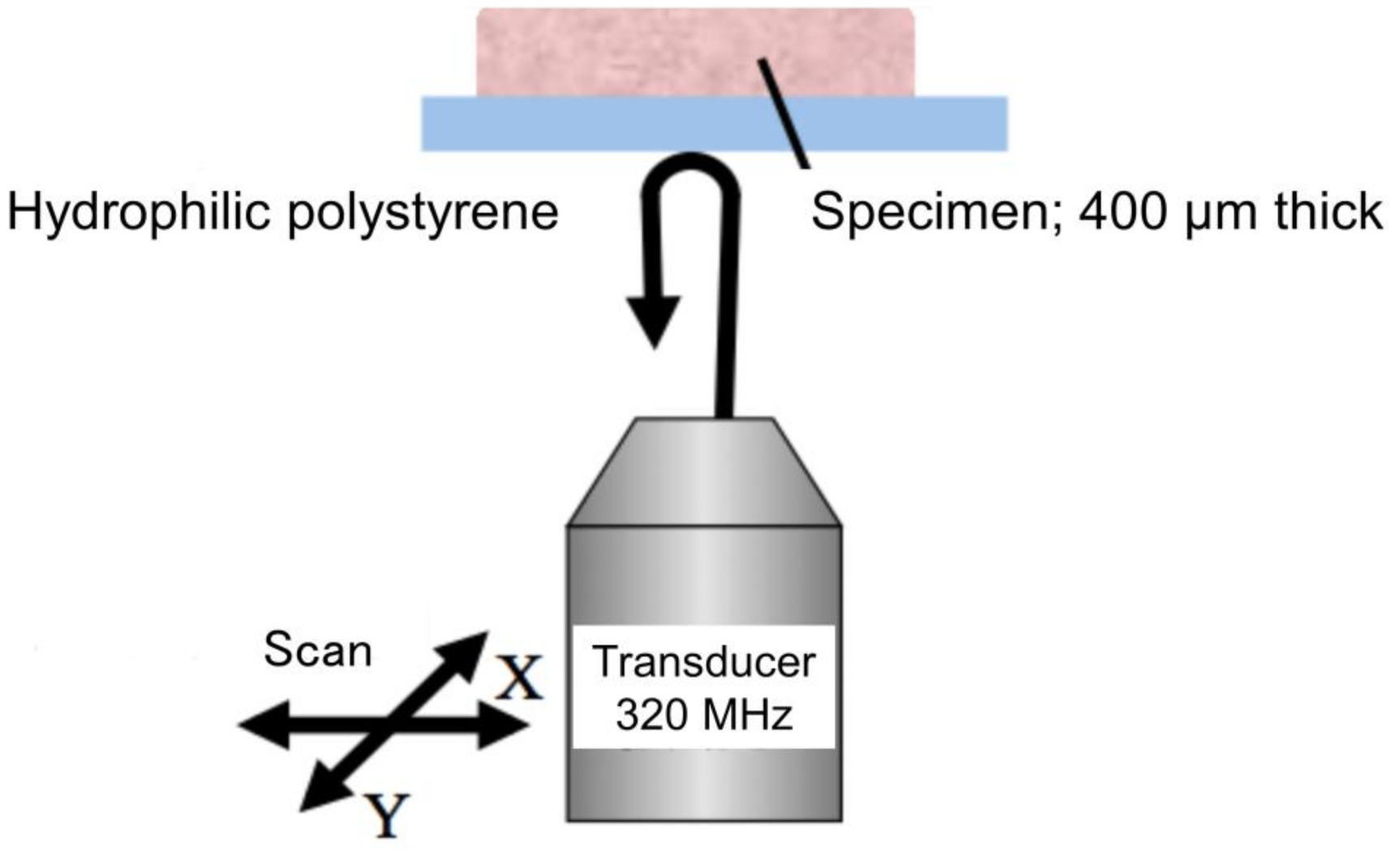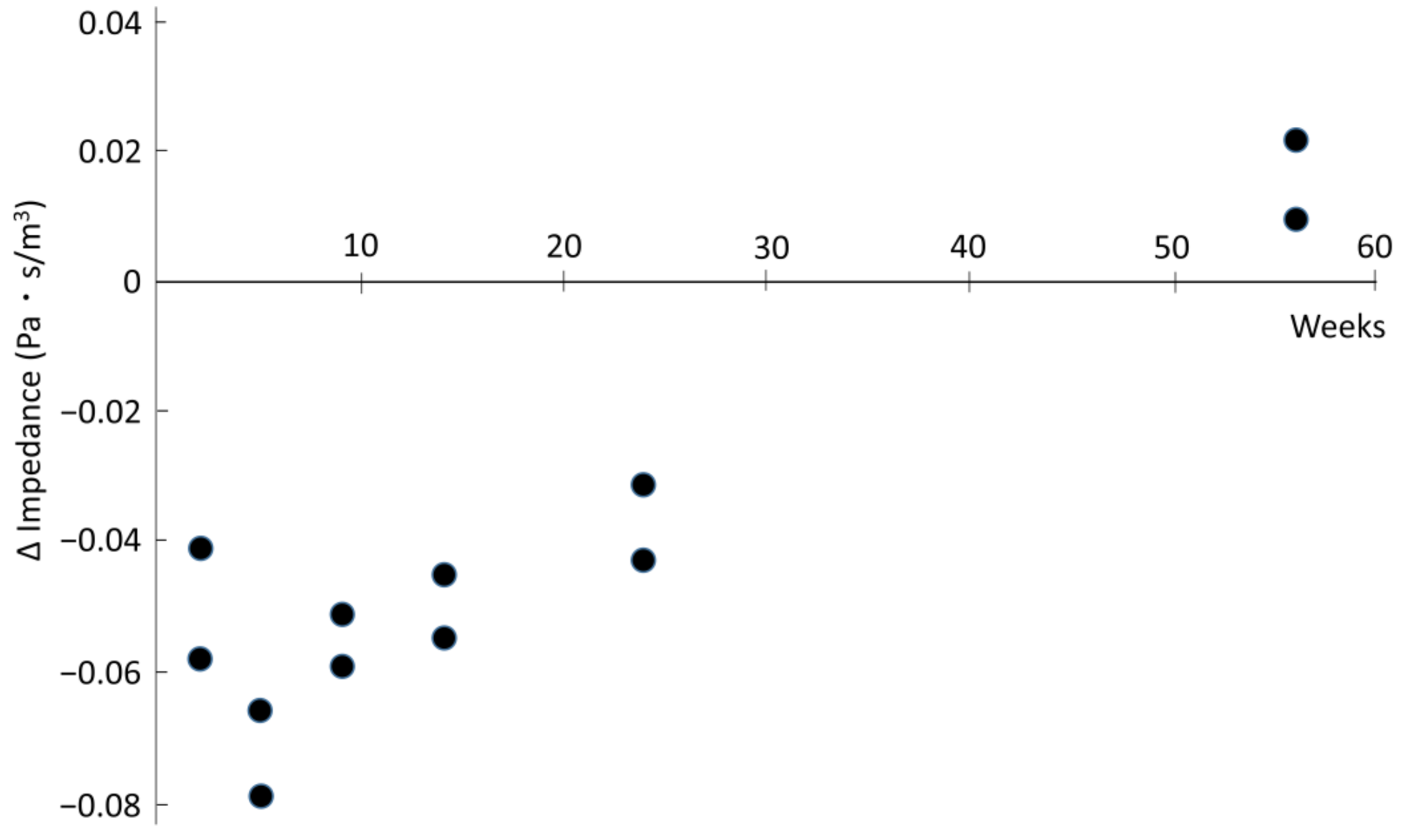Use of Ultrasound Microscopy for Ex Vivo Analysis of Acoustic Impedance in Mouse Liver with Steatohepatitis
Abstract
1. Introduction
2. Materials and Methods
2.1. Animals
2.2. Methods for Ultrasonic Analysis
2.3. Methods for Pathologic Analysis
2.4. Light Microscopy Observation of Sections Examined by SAM
2.5. Statistical Analysis
3. Results
3.1. Mouse Liver
3.2. Temporal Changes in Impedance through a Liver Affected by Steatohepatitis
3.3. Relationship between Acoustic Impedance and the Brunt System
3.4. Ultrasound Microscopic Images Based on Intensity in Liver Tissues
4. Discussion
5. Conclusions
Author Contributions
Funding
Institutional Review Board Statement
Informed Consent Statement
Data Availability Statement
Acknowledgments
Conflicts of Interest
References
- Saijo, Y. Recent applications of acoustic microscopy for quantitative measurement of acoustic properties of soft tissues. In Quantitative Ultrasound in Soft Tissues, 1st ed.; Mamou, J., Oelza, M.L., Eds.; Springer: Heidergerg, Germany, 2013; pp. 291–313. [Google Scholar]
- Miura, K.; Yamamoto, S. A scanning acoustic microscopy discriminates cancer cells in fluid. Sci. Rep. 2015, 5, 15243. [Google Scholar] [CrossRef] [PubMed]
- Miura, K.; Yamashita, K. Mechanical weakness of thoracic aorta related to aging or dissection predicted by speed of sound with collagenase. Ultrasound Med. Biol. 2019, 45, 3102–3115. [Google Scholar] [CrossRef] [PubMed]
- Ito, T.; Kanai, T.; Itoh, K.; Yamagata, T. Ultrasound microscopy through a fine fiber fore renal tissues. Clin. Exp. Nephrol. 2019, 23, 867–869. [Google Scholar] [CrossRef] [PubMed]
- Hagiwara, Y.; Saijo, Y.; Ando, A.; Onoda, Y.; Suda, H.; Chimoto, E.; Hatori, K.; Itoi, E. Comparison of articular cartilage images assessed by high-frequency ultrasound microscope and scanning acoustic microscope. Int. Orthop. 2012, 36, 185–190. [Google Scholar] [CrossRef] [PubMed]
- Sanyal, A.J. Past, present and future perspectives in nonalchoholic fatty liver disease. Nat. Rev. Gastroenterol. Hepatol. 2019, 16, 377–386. [Google Scholar] [CrossRef]
- Leporq, B.; Lambert, S.A.; Ronot, M.; Vilgrain, V.; van Beers, B.E. Quantification of the triglyceride fatty acid composition with 3.0 T MRI: quantification of triglyceride fatty acid composition with MRI. NMR Biomed. 2014, 27, 1211–1221. [Google Scholar] [CrossRef]
- Imbault, M.; Faccinetto, A.; Osmanski, B.F.; Tissier, A.; Deffieux, T.; Gennisson, J.; Vilgrain, V.; Tanter, M. Robust sound speed estimation for ultrasound-based hepatic steatosis assessment. Phys. Med. Biol. 2017, 62, 3582–3598. [Google Scholar] [CrossRef]
- Mehta, S.H.; Lau, B.; Afdhal, N.H.; Thomas, D.L. Exceeding the limits of liver histology markers. J. Hepatol. 2009, 50, 36–41. [Google Scholar] [CrossRef]
- Mehta, S.R.; Thomas, E.L.; Bell, J.D.; Johnston, D.G.; Taylor-Robinson, S.D. Non-invasive means of measuring hepatic fat content. World J. Gastroenterol. 2008, 14, 3476–3483. [Google Scholar] [CrossRef]
- Bouzitoune, R.; Meziri, M.; Machado, C.B.; Padilla, F.; Pereira, W.C. Can early hepatic fibrosis stages be discriminated by combining ultrasonic parameters? Ultrasonics 2016, 68, 120–126. [Google Scholar] [CrossRef]
- Bedossa, P.; Darger, D.; Paradis, V. Sampling variabilitiy of liver fibrosis in chronic hepatitis C. Hepatology 2003, 38, 1449–1457. [Google Scholar] [CrossRef] [PubMed]
- Brunt, E.M.; Tiniakos, D.G. Histopathology of nonalcoholic fatty liver disease. World J. Gastroenterol. 2010, 16, 5286–5296. [Google Scholar] [CrossRef] [PubMed]
- Dasarathy, S.; Dasarathy, J.; Khiyami, A.; Joseph, R.; Lopez, R.; McCullough, A.J. Validity of real time ultrasound in the diagnosis of hepatic steatosis: a prospective study. J. Hepatol. 2009, 51, 1061–1067. [Google Scholar] [CrossRef] [PubMed]
- Kulinski, A.; Vance, D.E.; Vance, J.E. A choline-deficient diet in mice inhibits neither the CDP-choline pathway for phosphatidylcholine synthesis in hepatocytes nor apolipoprotein B secretion. J. Biol. Chem. 2004, 279, 23916–23924. [Google Scholar] [CrossRef]
- Brunt, E.M.; Janney, C.G.; Di Bisceglie, A.M.; Neuschwander-Tetri, B.A.; Bacon, B.R. Nonalcoholic steatohepatitis: a proposal for grading and staging the histological lesions. Am. J. Gastroenterol. 1999, 94, 2467–2474. [Google Scholar] [CrossRef]
- Brunt, E.M. Nonalcoholic fatty liver disease: pros and cons of histologic systems of evaluation. Int. J. Mol. Sci. 2016, 17, 97. [Google Scholar] [CrossRef]
- Barr, R.J.; White, G.M.; Jones, J.P.; Shaw, L.P.; Ross, P.A. Scanning acoustic microscopy of neoplastic and inflammatory cutaneous tissue specimens. J. Invest. Dermatol. 1991, 96, 38–42. [Google Scholar] [CrossRef]
- Ito, K.; Yoshida, K.; Maruyama, H.; Mamou, J.; Yamaguchi, T. Acoustic impedance analysis with high-frequency ultrasound for identification of fatty acid species in the liver. Ultrasound Med. Biol. 2017, 43, 700–711. [Google Scholar] [CrossRef]
- Nahon, P.; Kettaneh, A.; Tengher-Barna, I.; Ziol, M.; de Ledinghen, V.; Douvin, C.; Marcellin, P.; Ganne-Carrie, N.; Trinchet, J.C.; Beaugrand, M. Assessment of liver fibrosis using transient elastography in patients with alcoholic liver disease. J. Hepatol. 2008, 49, 1062–1068. [Google Scholar] [CrossRef]
- Ogawa, S.; Moriyasu, F.; Yoshida, K.; Oshiro, H.; Kojima, M.; Sano, T.; Furuichi, Y.; Kobayashi, Y.; Nakamura, I.; Sugimoto, K. Relationship between liver tissue stiffness and histopathological findings analyzed by shear wave elastography and compression testing in rats with non-alcoholic steatohepatitis. J. Med. Ultrasonics. 2016, 43, 355–360. [Google Scholar] [CrossRef]
- Apfel, R.E. Prediction of tissue composition from ultrasonic measurements and mixture rules. J. Acoust. Soc. Am. 1986, 79, 148–152. [Google Scholar] [CrossRef] [PubMed]




| Mouse | Time on a Diet (Week) | Impedance (Pa·s/m3) | Brunt System | ||
|---|---|---|---|---|---|
| Steatosis | Inflammation | Fibrosis | |||
| Steatohepatitis | |||||
| S1 | 2 | 1.535 | 1 | 1 | 0 |
| S2 | 2 | 1.552 | 1 | 1 | 0 |
| S3 | 5 | 1.515 | 3 | 1 | 0 |
| S4 | 5 | 1.528 | 3 | 1 | 0 |
| S5 | 9 | 1.543 | 3 | 2 | 1 |
| S6 | 9 | 1.551 | 3 | 2 | 1 |
| S7 | 14 | 1.559 | 3 | 1 | 2 |
| S8 | 14 | 1.569 | 2 | 2 | 2 |
| S9 | 24 | 1.561 | 3 | 2 | 2 |
| S10 | 24 | 1.573 | 2 | 3 | 3 |
| S11 | 56 | 1.560 | 2 | 3 | 3 |
| S12 | 56 | 1.572 | 1 | 2 | 3 |
| Control | |||||
| C1 | 2 | 1.593 | 0 | 0 | 0 |
| C2 | 5 | 1.594 | 0 | 0 | 0 |
| C3 | 9 | 1.602 | 0 | 0 | 0 |
| C4 | 14 | 1.614 | 0 | 0 | 0 |
| C5 | 24 | 1.604 | 0 | 0 | 0 |
| C6 | 56 | 1.550 | 0 | 0 | 0 |
Publisher’s Note: MDPI stays neutral with regard to jurisdictional claims in published maps and institutional affiliations. |
© 2020 by the authors. Licensee MDPI, Basel, Switzerland. This article is an open access article distributed under the terms and conditions of the Creative Commons Attribution (CC BY) license (http://creativecommons.org/licenses/by/4.0/).
Share and Cite
Kumagai, H.; Kobayashi, K.; Yoshida, S.; Yokoyama, K.; Hirota, N.; Yamagata, T. Use of Ultrasound Microscopy for Ex Vivo Analysis of Acoustic Impedance in Mouse Liver with Steatohepatitis. Acoustics 2021, 3, 3-10. https://doi.org/10.3390/acoustics3010002
Kumagai H, Kobayashi K, Yoshida S, Yokoyama K, Hirota N, Yamagata T. Use of Ultrasound Microscopy for Ex Vivo Analysis of Acoustic Impedance in Mouse Liver with Steatohepatitis. Acoustics. 2021; 3(1):3-10. https://doi.org/10.3390/acoustics3010002
Chicago/Turabian StyleKumagai, Hideki, Kazuto Kobayashi, Sachiko Yoshida, Koji Yokoyama, Norio Hirota, and Takanori Yamagata. 2021. "Use of Ultrasound Microscopy for Ex Vivo Analysis of Acoustic Impedance in Mouse Liver with Steatohepatitis" Acoustics 3, no. 1: 3-10. https://doi.org/10.3390/acoustics3010002
APA StyleKumagai, H., Kobayashi, K., Yoshida, S., Yokoyama, K., Hirota, N., & Yamagata, T. (2021). Use of Ultrasound Microscopy for Ex Vivo Analysis of Acoustic Impedance in Mouse Liver with Steatohepatitis. Acoustics, 3(1), 3-10. https://doi.org/10.3390/acoustics3010002





